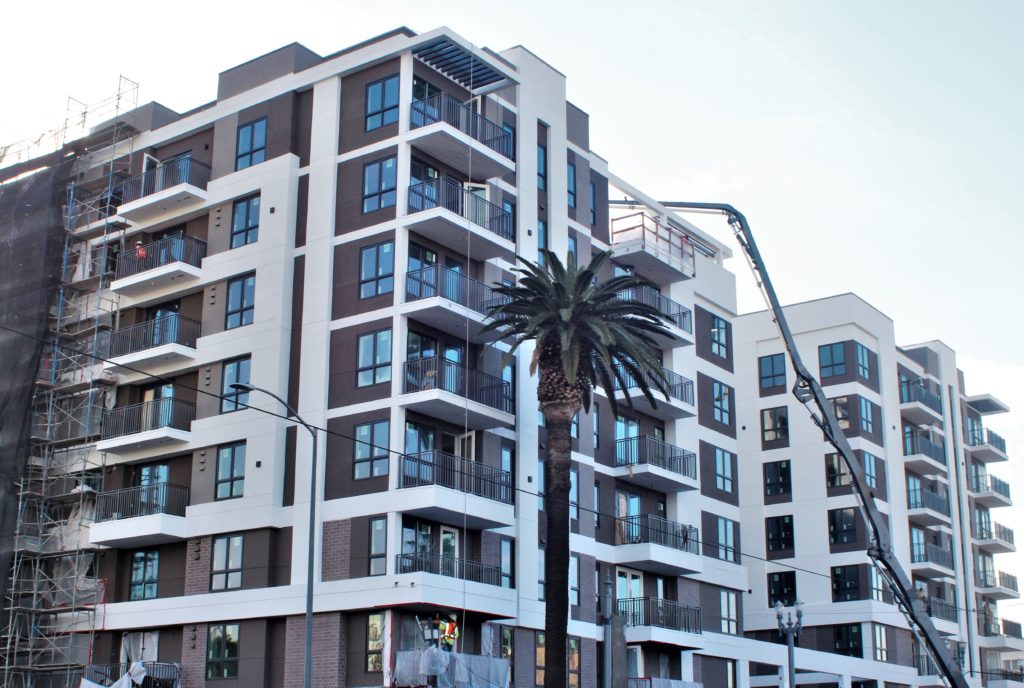
The Volta, a new residential complex in Downtown Long Beach and 7th Street and Pine Avenue.
On January 15, the Downtown Long Beach Alliance (DLBA) released the Q4 Residential Snapshot Report, an in-depth look at the Downtown Long Beach residential market. The report reveals how Downtown’s market stacks up against other regional cities in the wake of the COVID-19 crisis, how Downtown landlords and leasing agents are providing incentives for prospective residents, and how the pandemic may influence the future for Downtown residences and businesses.
Factors related to living in Downtown, such as demographics, age of rental buildings, and street parking factors, are also examined in detail.
Morris Mills, DLBA’s Research and Policy Analyst, provided a summary of how the Downtown residential market fared in 2020. “Overall, the Downtown residential market underwent slight fluctuations from the beginning to the end of 2020,” he explained. “Obviously, COVID-19 is the underlying force affecting price, occupancy, and construction progress. Occupancy in Downtown as of Q4 was 93%, which is middle-of-the-pack as far as other cities go.”
Occupancy rates indicate how many residences in an area are lived in, Mills said, noting that Downtown occupancy rates dipped in the middle of 2020 but came back in Q4 to where they were before the pandemic started. Mills mentioned that this market could be called “stagnant, but in this economy that’s not a bad thing.”
Compared to the other segments of the Downtown real estate market — retail, which bore the brunt of most of the COVID-19 restrictions, and offices, which were affected by people pivoting to work-from-home scenarios — the residential market was definitely more stable. “People are always going to need somewhere to live,” Mills said.
Nearly 90% of Downtown residences are rentals. In 2020, many Downtown landlords and leasing agents adapted to the market-slowing effects of the pandemic by offering concessions to potential tenants such as a period of free or reduced rent, payment of moving expenses, or some kind of financial allowance. “In the report we saw that the rate of people giving concessions to potential Downtown tenants went up, especially in ‘Class A’ buildings, which are newer and have more amenities,” said Mills.
The report also cites the potential of the City’s new micro unit pilot program. “Micro-units — residences occupying roughly 220 square feet — are promising for Downtown,” said Mills. “A lot of the normal, square parcels of land that are easy to develop are running out, so more innovative solutions are needed. There are lots of skinny, rectangular plots where shipping container units can fit, which will create more affordable housing opportunities in Downtown.”
The interconnectedness of Downtown residents and businesses will be a key factor in the post-COVID recovery in Downtown. The daily daytime Downtown population of workers, shoppers, and visitors, which averaged around 40,000 before the pandemic, has been reduced to a fraction of that due to shop and office closures. “It remains to be seen how some businesses will come back, which will affect residents and tenants who patronize them,” said Mills. “The key question is, to what degree will Downtown try to adjust back to pre-COVID conditions, versus trying to make adjustments for the new economy.”
As recovery begins, DLBA will continue to examine data compiled from such sources as the U.S. Census Bureau and CoStar, a top provider of commercial real estate information. Working with the City and with its many public-facing committees, DLBA will use this data to identify trends and to help Downtown return to a state of thriving good health and good business.
